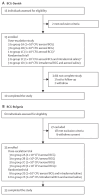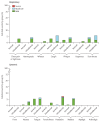Safety of a controlled human infection model of tuberculosis with aerosolised, live-attenuated Mycobacterium bovis BCG versus intradermal BCG in BCG-naive adults in the UK: a dose-escalation, randomised, controlled, phase 1 trial
- PMID: 38621405
- PMCID: PMC7618001
- DOI: 10.1016/S1473-3099(24)00143-9
Safety of a controlled human infection model of tuberculosis with aerosolised, live-attenuated Mycobacterium bovis BCG versus intradermal BCG in BCG-naive adults in the UK: a dose-escalation, randomised, controlled, phase 1 trial
Abstract
Background: Mycobacterium tuberculosis is the main causative agent of tuberculosis. BCG, the only licensed vaccine, provides inadequate protection against pulmonary tuberculosis. Controlled human infection models are useful tools for vaccine development. We aimed to determine a safe dose of aerosol-inhaled live-attenuated Mycobacterium bovis BCG as a surrogate for M tuberculosis infection, then compare the safety and tolerability of infection models established using aerosol-inhaled and intradermally administered BCG.
Methods: This phase 1 controlled human infection trial was conducted at two clinical research facilities in the UK. Healthy, immunocompetent adults aged 18-50 years, who were both M tuberculosis-naive and BCG-naive and had no history of asthma or other respiratory diseases, were eligible for the trial. Participants were initially enrolled into group 1 (receiving the BCG Danish strain); the trial was subsequently paused because of a worldwide shortage of BCG Danish and, after protocol amendment, was restarted using the BCG Bulgaria strain (group 2). After a dose-escalation study, during which participants were sequentially allocated to receive either 1 × 103, 1 × 104, 1 × 105, 1 × 106, or 1 × 107 colony-forming units (CFU) of aerosol BCG, the maximum tolerated dose was selected for the randomised controlled trial. Participants in this trial were randomly assigned (9:12), by variable block randomisation and using sequentially numbered sealed envelopes, to receive aerosol BCG (1 × 107 CFU) and intradermal saline or intradermal BCG (1 × 106 CFU) and aerosol saline. Participants were masked to treatment allocation until day 14. The primary outcome was to compare the safety of a controlled human infection model based on aerosol-inhaled BCG versus one based on intradermally administered BCG, and the secondary outcome was to evaluate BCG recovery in the airways of participants who received aerosol BCG or skin biopsies of participants who received intradermal BCG. BCG was detected by culture and by PCR. The trial is registered at ClinicalTrials.gov, NCT02709278, and is complete.
Findings: Participants were assessed for eligibility between April 7, 2016, and Sept 29, 2018. For group 1, 15 participants were screened, of whom 13 were enrolled and ten completed the study; for group 2, 60 were screened and 33 enrolled, all of whom completed the study. Doses up to 1 × 107 CFU aerosol-inhaled BCG were sufficiently well tolerated. No significant difference was observed in the frequency of adverse events between aerosol and intradermal groups (median percentage of solicited adverse events per participant, post-aerosol vs post-intradermal BCG: systemic 7% [IQR 2-11] vs 4% [1-13], p=0·62; respiratory 7% [1-19] vs 4% [1-9], p=0·56). More severe systemic adverse events occurred in the 2 weeks after aerosol BCG (15 [12%] of 122 reported systemic adverse events) than after intradermal BCG (one [1%] of 94; difference 11% [95% CI 5-17]; p=0·0013), but no difference was observed in the severity of respiratory adverse events (two [1%] of 144 vs zero [0%] of 97; 1% [-1 to 3]; p=0·52). All adverse events after aerosol BCG resolved spontaneously. One serious adverse event was reported-a participant in group 2 was admitted to hospital to receive analgesia for a pre-existing ovarian cyst, which was deemed unrelated to BCG infection. On day 14, BCG was cultured from bronchoalveolar lavage samples after aerosol infection and from skin biopsy samples after intradermal infection.
Interpretation: This first-in-human aerosol BCG controlled human infection model was sufficiently well tolerated. Further work will evaluate the utility of this model in assessing vaccine efficacy and identifying potential correlates of protection.
Funding: Bill & Melinda Gates Foundation, Wellcome Trust, National Institute for Health Research Oxford Biomedical Research Centre, Thames Valley Clinical Research Network, and TBVAC2020.
Copyright © 2024 The Author(s). Published by Elsevier Ltd. This is an Open Access article under the CC BY 4.0 license. Published by Elsevier Ltd.. All rights reserved.
Conflict of interest statement
Declaration of interests We declare no competing interests.
Figures





References
-
- WHO. Global tuberculosis report 2021. 2021. Oct 14, [accessed Dec 16, 2023]. https://www.who.int/publications/i/item/9789240037021 .
-
- Fine PE. The BCG story: lessons from the past and implications for the future. Rev Infect Dis. 1989;11(suppl 2):S353–59. - PubMed
Publication types
MeSH terms
Substances
Associated data
Grants and funding
LinkOut - more resources
Full Text Sources
Medical
Miscellaneous

